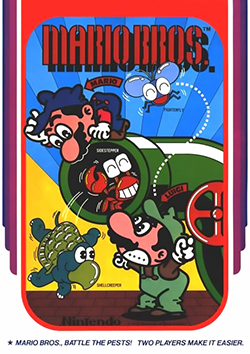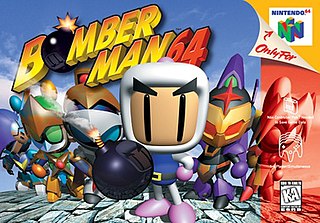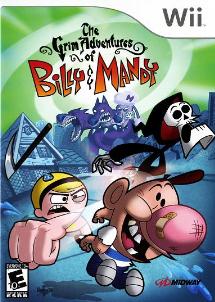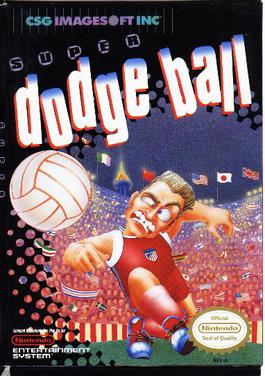
Mario Bros. is a platform game developed and published by Nintendo as an arcade video game in 1983. It was designed by Shigeru Miyamoto and Gunpei Yokoi, Nintendo's chief engineer. Italian twin brother plumbers Mario and Luigi exterminate creatures, like turtles (Koopas) and crabs emerging from the sewers by knocking them upside-down and kicking them away. The Famicom/Nintendo Entertainment System version is the first game produced by Intelligent Systems. It is part of the Mario franchise, but originally began as a spin-off from the Donkey Kong series.

Bomberman 64 is a video game developed by Hudson Soft, published by Hudson Soft in Japan, and published by Nintendo in North America and Europe for the Nintendo 64. The game was released in Europe and North America in November and December 1997, respectively. While the game never saw a release on the Wii's Virtual Console service, it was eventually released on the Wii U Virtual Console in both Europe and North America in March 2017 followed by Japan in June 2017.

Super Dodge Ball is a dodgeball-based sports game produced by Technos Japan Corp. originally released as an arcade game in 1987. In Japan, it was the second game starring Technos Japan's video game character Kunio-kun, following Nekketsu Kōha Kunio-kun, although the connection between the two games was removed in the western release. Various home versions and sequels of the game have been released for various platforms.

Pinball is a pinball video game developed by Nintendo and HAL Laboratory and published by Nintendo for the Nintendo Entertainment System. It is based on a Game & Watch unit of the same name, and was first released for the Famicom in Japan in 1984. It was later released as an arcade game for the Nintendo VS. System in Japan and North America in 1984. In 1985, it was a launch game for the Nintendo Entertainment System in North America.

Hudson's Adventure Island, known as Takahashi Meijin no Bōken Jima in Japan and also known as Adventure Island, is a side-scrolling platform game produced by Hudson Soft that was released in Japan for the Famicom and MSX on September 12, 1986. Adventure Island was released in North America for the Nintendo Entertainment System in 1988 and in the PAL region in 1992.

Double Dribble is an arcade basketball video game developed and released by Konami in 1986. It was the second basketball arcade video game by Konami, following Super Basketball. It was considered the most realistic basketball sports video game upon release, with fast-paced action, detailed players, a large side-scrolling court, innovative cinematic slam dunks, and detailed sound effects, beginning a trend where presentation would play an increasingly important role in sports games.

Sonic and the Secret Rings is a 2007 platform video game developed by Sonic Team and published by Sega for the Wii. A spin-off from the Sonic the Hedgehog series, it is the first title in the franchise for the system, and follows Sonic the Hedgehog's quest to stop an evil genie named the Erazor Djinn. In addition to the basic platforming gameplay of previous Sonic titles, Secret Rings uses a system of experience points and levels, as well as special moves that are unlocked via leveling up.

Excite Truck is a racing video game developed by Nintendo and Monster Games and published by Nintendo for the Wii. It features malleable environments and tilt-based controls. The game was one of the Wii launch titles in North America. It is the third main game in the Excite series and the first to feature vehicles other than motorbikes.

WarioWare: Smooth Moves is a party video game developed by Nintendo SPD and Intelligent Systems. The game was published by Nintendo for its Wii video game system in Japan in December 2006, and in Europe, North America, and Australia in January 2007. It is the fifth game in the WarioWare series of games, and the only game in the series to be physically released for the Wii. Like its predecessors, WarioWare: Smooth Moves is built around a collection of microgames that last about five seconds each, and which require that the player hold the Wii Remote in specific positions. The game offers the microgames to the player in rapid succession, by first instructing the player to hold the Wii Remote in a specific manner, and then showing them the microgame. The microgames are divided into several stages, each of which loosely connects the microgames with the help of a story. Additionally, this was the first spin-off Mario game to be released for the console.

Mappy-Land is a video game console-only sequel to the 1983 Namco/Midway arcade game Mappy. The game was developed by TOSE and published by Namco in Japan and Taxan in North America for the Nintendo Entertainment System. It was later released by Bandai Namco Entertainment for the Wii U Virtual Console worldwide in February 2015, and on the Nintendo Switch Online Service in March 2022.

The Grim Adventures of Billy & Mandy is a fighting video game published by Midway Home Entertainment based on the Cartoon Network animated television series of the same name. The game was developed by High Voltage Software and released in North America on September 25, 2006, for the GameCube and PlayStation 2, and on November 19, 2006, for the Wii as a launch title. A companion game for the Game Boy Advance, featuring sidescrolling beat 'em up gameplay, was developed by Full Fat and released on October 31, 2006. The Wii version was released in Australia on March 15, 2007, and in Europe on March 16, 2007. The game pits characters from the series against one another in 3D arena battles using various attacks, items, and environmental hazards to eliminate opponents and be the last one standing.

Wii Play is a party video game developed and published by Nintendo for the Wii console. It was released as a launch game for the console in Japan, Europe, and Australia in December 2006, and was released in North America in February 2007. The game features nine minigames, including a Duck Hunt-esque shooting range, a fishing game, and a billiards game, each of which are designed to showcase the features of the Wii Remote controller.

A ball-up in Australian rules football is the method by which the field umpire restarts play at a neutral contest after a stoppage within the field of play. It involves the throwing or bouncing of the ball up between two players, known as rucks, who then attempt to win possession for their teams.

Kirby is an action-platform video game series developed by HAL Laboratory and published by Nintendo. The series centers around the adventures of a pink round hero named Kirby as he fights to protect and save his home on the distant Planet Popstar from a variety of threats. The majority of the games in the series are side-scrolling platformers with puzzle-solving and beat 'em up elements. Kirby has the ability to inhale enemies and objects into his mouth, spitting them out as a projectile or eating them. If he inhales certain enemies, he can gain the powers or properties of that enemy manifesting as a new weapon or power-up called a Copy Ability. The series is intended to be easy to pick up and play even for people unfamiliar with action games, while at the same time offering additional challenge and depth for more experienced players to come back to.

Dragon Ball Z: Budokai Tenkaichi, released in Japan as Dragon Ball Z: Sparking!, is a series of fighting games developed by Spike based on the Dragon Ball manga series by Akira Toriyama. The series was published by Namco Bandai Games in Japan and Europe, and by Atari in North America and Australia until 2008. Since Budokai Tenkaichi 3, Bandai Namco has handled Dragon Ball game publishing in all regions, effectively ending Atari's involvement.

New Super Mario Bros. Wii is a platform video game developed and published by Nintendo for the Wii. A follow-up to New Super Mario Bros., it was first released in Australia, North America, and Europe in November 2009, followed by Japan a month later. A high-definition port for the Nvidia Shield TV was released in China in December 2017. Like other side-scrolling Super Mario games, the player controls Mario as he travels eight worlds and fights Bowser's henchmen to rescue Princess Peach. New Super Mario Bros. Wii was the first Super Mario game to feature simultaneous cooperative multiplayer gameplay; up to four people can play in cooperative and competitive multiplayer modes, taking control of Mario as well as Luigi and one of two multicolored Toads. The game also introduces "Super Guide", which allows the player to watch a computer-controlled character complete a level.

Super Monkey Ball: Step & Roll is a platform video game developed and published by Sega for the Wii. It was released in February 2010 worldwide.

Sports Champions is a 2010 sports video game developed by San Diego Studio and Zindagi Games and published by Sony Computer Entertainment for PlayStation 3, which utilizes PlayStation Move. It was officially unveiled at the 2010 Game Developers Conference in San Francisco. The game is a collection of modern and medieval sports games published by Sony Computer Entertainment and was jointly developed by San Diego Studio and Zindagi Games as a launch game for the PlayStation Move which would be bundled with the controller in several regions.

Super Contra, known as Super Contra: The Alien Strikes Back in Japan, is a run and gun video game by Konami, originally released as a coin-operated arcade video game in January 1988. It is the sequel to the original Contra and part of the Contra series. The game stars Bill Rizer and Lance Bean as they are sent to thwart another alien invasion from the vicious Red Falcon.

Super Dodge Ball is a sports video game developed and published by Technōs Japan that was for the Nintendo Entertainment System in 1989. It is loosely based on the 1987 arcade game of the same name, which was also developed by Technōs. Like its arcade counterpart, it was released in Japan as part of the Kunio-kun series.


















